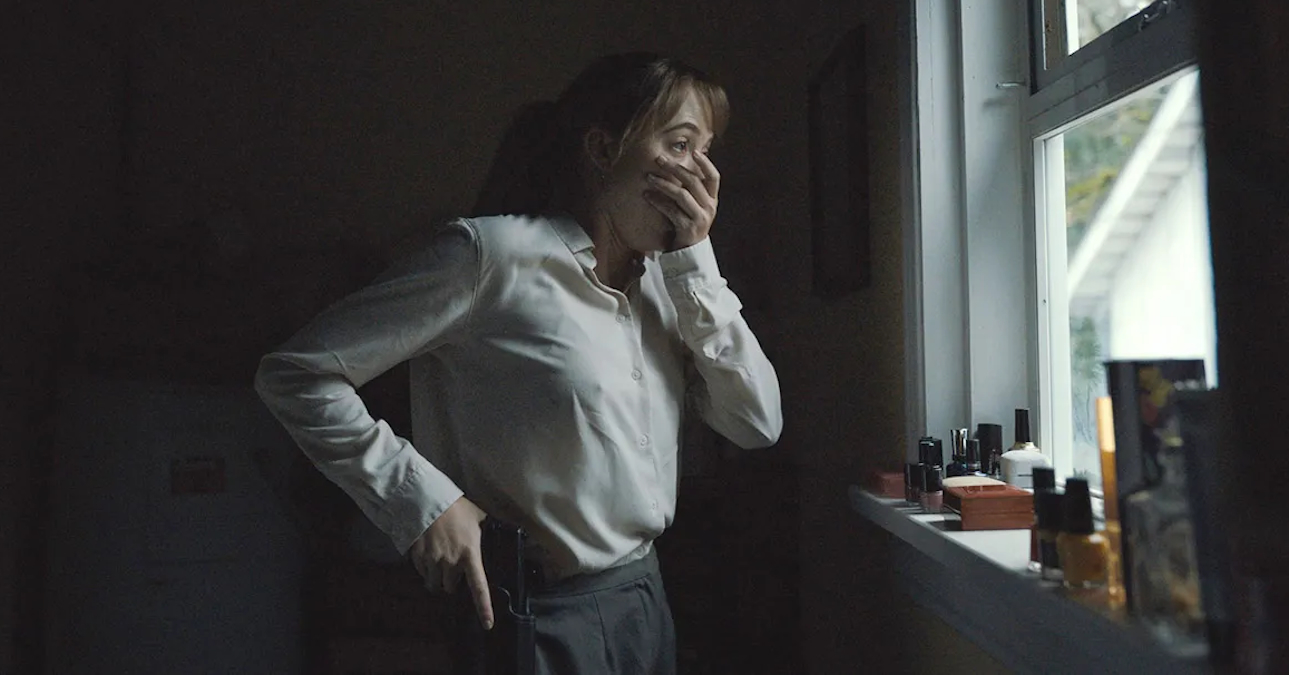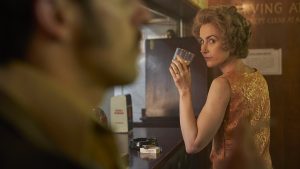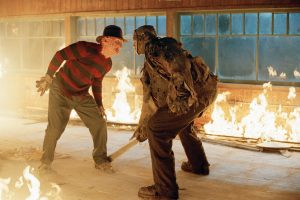
This article contains major Longlegs spoilers.
A mother is dead. A whole other family is ruined. And a doll survives. These are the sinister details which sum up the final scene of Longlegs, Oz Perkins’ nasty little mash-up of serial killer thrillers with “the devil made me do it” religious horror movies. In the film’s closing moments, poor Lee Harker (Maika Monroe) at last understands that her own mother Ruth (Alicia Witt) is the accomplice to Nicolas Cage’s “Longlegs” serial killer. And though the fiend is dead, dear mom was still in service to “Mr. Downstairs.”
Hence the ending of the movie where Lee realizes the darkness that compelled seemingly good men like Blair Underwood’s FBI boss to murder their families had also shielded Agent Harker from remembering her own run-in with daddy Longlegs as a child. Ruth never did though. She remembers that day well, just as she remembers the evil presence that emanated from Longlegs’ various dolls—each containing a totem or piece of the Devil’s power in its head. She was able to resist that evil’s command to kill her daughter, but Lee’s reprieve has meant a lifetime of hellish servitude. Even after Longlegs is gone, there still remains Ruth and the Devil she follows long after the doll in her own house is destoryed.
The film, then, concludes with Ruth breathlessly telling her daughter that they shall writhe in the fires of Hell unless every member of the Carter family, including a little girl, dies as some kind of Satanic sacrifice. Instead Lee shoots her mother in the head and flees the house. It’s a grim denouement that might even ask if Lee is damned too?
“I think the ending for her is about as bad as it could have turned out,” Perkins muses when we chat about the last moments of Longlegs. “Like shooting her mom in the head, that’s about as bad a day as a person can have. So I think that ultimately one could say that the entire movement of the movie—or the entire movement of all of Longlegs’ crimes, starting from crime number one all the way to the Carter family—it’s all about getting this poor girl to a place where she shoots her mom in the head. Like that’s kind of the flourish, the Devil’s ‘Yep, I did that.’”
The nature of evil, and how folks can become complicit in their own destruction and self-made damnations, is a recurring theme in Longlegs and other works by Perkins, including his feature directorial debut, The Blackcoat’s Daughter. In both of these films, folks are seduced or consumed by evil, be it as a metaphor or a literal manifestation of the Devil.
Ruth thinks of herself as a Christian woman, yet she is convinced her salvation will only come from doing Satan’s bidding and poisoning parents to murder their children. Those parents, in turn, also are made complicit in the horror. Ruth was able to somewhat resist evil’s compulsion by not killing her daughter, but the likable FBI veteran played by Underwood willingly walked into the kitchen with every intention of gutting his wife. He didn’t even try to fight the temptation.
This carries on from a similar theme in The Blackcoat’s Daughter where we watch a little girl (played by Kiernan Shipka) become possessed by the Devil and then turn out to enjoy merging with the entity.
“When dealing with the characters I’ve written, they’re typically lost people who just get picked up,” Perkins explains. “They’re hitchhiking on the road of life and they get picked up by the wrong car, and then life sort of takes its course. And when you’re dealing with something as appealing as the Devil is supposed to be—that’s his thing, right? He’s appealing. It’s interesting to see characters who have kind of fallen for it, even though it’s ultimately destructive to them.”
The film isn’t so much about literal devil worship (although the final image is an alternate take of Cage’s Longlegs saying “hail Satan” before offing himself). Rather it is about how people let their demons, literal or figurative, consume them until they become something inhuman or unrecognizable either to themselves or their loved ones. Perkins and Cage have also talked to the press, including us, about how the movie is a metaphor to deal with parents who struggled with mental illness.
Ruth thinks she is saving her and her daughter’s souls by facilitating the murder of innocent families, however she is actually damning herself to literal Hell and her daughter Lee to a figurative one since, to save a child, she has to put mama down.
At the end of the movie, there is no salvation or saving grace. Yes, a child is alive, but the child is already enamored with “the wrong car,” clinging to the evil doll not unlike little Shipka adored the evil inside her in The Blackcoat’s Daughter. Is she really spared from its touch after experiencing the lifelong trauma of hearing her father kill her mother, and then seeing him attempt to kill her while covered in blood?
Similarly, Lee will always live with the horror of what she did to her mother… and the doll is left untouched. Evil, whether as a spiritual entity or just an abstract idea created by human beings giving into their worst impulses, never really dies. It’s eternal, and once it’s touched your life, you’re forever forced to go down a different, darker road than you would have liked. A parent’s devils become your own.
Longlegs is in theaters now.
The post Longlegs Ending Explained with Director Oz Perkins appeared first on Den of Geek.





